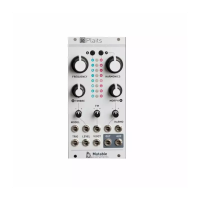| init|send|save|versions more|exit
The first row displays the following information:
is the current “object”, that is to say the kind of thing you want to load/save from/to the
memory card. In this case, you will be browsing the list of programs and they will be loaded into part
indicates the bank and object number. Banks are identified by a letter from A to Z ; objects are
identified by a number from 000 to 127. The dot before
indicates that the version in memory is
different from the version stored on the card.
is the object (here a program) name.
The second row is a list of commands. Each command is associated with a switch. For example,
command. To quit the library
page, you thus have to press
to repeatedly cycle through the different types of items that can be loaded/written from/to
will load/save all the sound synthesis settings, but not the sequencer/arpeggiator
parameters of the Nth part.
will load/save all the sequencer/arpeggiator settings of the Nth part.
will load/save all the settings of the Nth part (synthesis, arpeggiator and sequencer).
will load/save all the settings of all parts.
Remember that you can hold
while turning the encoder to change the active part.
Ambika can store 3328 (26 banks of 128) patches/sequences/programs/multis.
Loading programs/multis/sequences/patches
Turn the encoder to move to the previous/next program. Remember that you can hold
turning the encoder to scroll faster in the list. To change the current bank:
Click the encoder. The bank letter starts blinking.
Ambika – User manual | Mutable Instruments http://mutable-instruments.net/ambika/manual
32 of 44 2/17/17 4:58 PM

